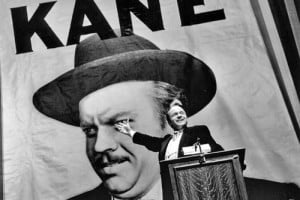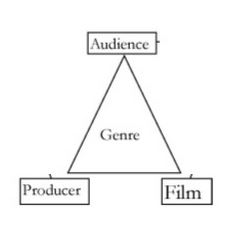UNIT 10 – Genre – week 2
Last week we discussed the role of narrative within fiction film and looked at the purpose of different formats and the ways in which different narratives are structured. I recommended that you watch some of the examples we looked at in class, which include;

Citizen Kane (1940) Dir. Orson Welles
PULP FICTION (1994) Dir. Quentin Tarantino
CITIZEN KANE (1940) Dir. Orson Welles
BOYHOOD (2014) Dir. Richard Linklater
VICTORIA (2015) Dir. Sebastian Schipper
The first two films are available on e-stream (click on the links). The other two I shall screen as lunchtime supplementary sessions for those of you who are interested.
This week we shall start by looking at GENRE and how it has an impact on different types of fiction film story-telling. Film genres are defined as being categories based on similarities in either the narrative elements or the emotional response to the film (namely, serious, comic, etc.). Most theories of film genre are borrowed from literary genre criticism.
Look at the following quotes about genre by some media theorists and see if you understand what they are saying;
Steve Neale (1980) “Genre is a set of great expectations.”
Rick Altman (1999) “Genre offers audiences a set of pleasures.”
Nicholas Abercrombie (1996) “The boundaries between genres are shifting and becoming more permeable.”
The first two quotes (Neale and Altman) suggest that genre is an unwritten contact between producers and audiences; audiences have a set of expectations surrounding a film (e.g. a sci-fi will perhaps feature space, aliens and galactic battles). It is up to the producers of the film to fulfil audience expectations and deliver associated generic pleasures.
 Tom Ryall proposes a theory in which links the film institution, film and audience – suggesting that they are all reliant on each other. The institution produces a film of a certain genre which generates money through audiences buying into the film, and the money generated goes back into the institution to produce more films of that genre. This process will continue until the genre becomes less popular with audiences.
Tom Ryall proposes a theory in which links the film institution, film and audience – suggesting that they are all reliant on each other. The institution produces a film of a certain genre which generates money through audiences buying into the film, and the money generated goes back into the institution to produce more films of that genre. This process will continue until the genre becomes less popular with audiences.
In the third quote (Abercrombie) the theorist highlights how the growing sophistication of film audiences has allowed generic boundaries to shift and create HYBRIDS. A hybrids is a genre that blends themes and elements from two or more different genres – for example Scary Movie (2000) is a slasher-horror- comedy and Cowboys Vs. Aliens (2011) is a sci-fi western.
If you want more background on genre theory read Daniel Chandler’s excellent An Introduction to Genre Theory. WARNING; it is difficult, but it will provide you with almost everything you will need or want to know about why genre is so important in the study of film and media.
M